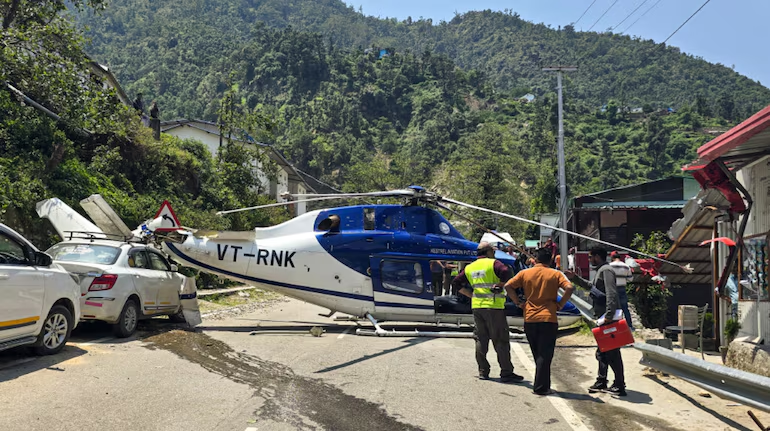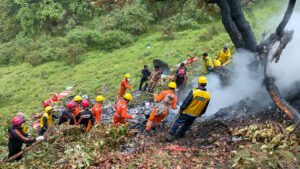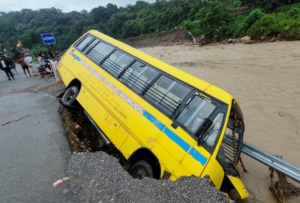Authorities have filed criminal charges against two aviation officials following a devastating helicopter crash that claimed seven lives near the sacred Kedarnath shrine. The incident has prompted immediate safety measures including the suspension of helicopter operations across the region.
Kedarnath Helicopter Crash: Legal Action Against Aviation Officials
Law enforcement officials have registered a First Information Report (FIR) against Aryan Aviation’s key personnel responsible for flight operations. The charges target Accountable Manager Kaushik Pathak along with Manager Vikas Tomar, who oversaw the company’s helicopter services for pilgrims visiting the holy site.
The legal action proceeds under section 105 of the Bharatiya Nyaya Sanhita (BNS) as well as section 10 of the Aircraft Act. These provisions address criminal negligence in aviation operations that result in loss of life.
Following the crash, aviation regulators immediately suspended Aryan Aviation’s operations for the Char Dham Yatra pilgrimage season. This decisive action prevents the company from conducting further flights until investigations conclude.
Immediate Safety Measures Implemented
Uttarakhand Chief Minister Pushkar Singh Dhami announced comprehensive safety measures in response to the tragedy. All charter helicopter operations in the region face suspension on June 15th through 16th as a precautionary measure.
The temporary halt affects shuttle services that transport thousands of pilgrims to remote mountain shrines during peak pilgrimage season. State officials prioritize passenger safety over commercial operations while reviewing current aviation protocols.
Kedarnath Helicopter Crash: Details of the Fatal Crash
The tragic incident occurred at approximately 5:20 AM on Sunday morning when the Bell 407 helicopter departed from Kedarnath Dham bound for Guptkashi. The aircraft crashed near Gaurikund, claiming all seven lives on board.
The victims included:
- Five adult passengers
- One infant passenger
- One crew member
All occupants perished in the crash, making it one of the deadliest aviation accidents in the region’s recent history.
Investigation Reveals Probable Cause
Chief Minister Dhami attributed the crash to adverse weather conditions that created dangerous flying circumstances. Initial investigations point to poor visibility as the primary contributing factor in the accident.
Government statements indicate that preliminary findings suggest the helicopter experienced a Controlled Flight into Terrain (CFIT). This aviation term describes situations where operational aircraft inadvertently fly into mountainous terrain while remaining under pilot control.
The crash likely occurred because the helicopter was operating in:
- Severely reduced visibility conditions
- Heavy cloud cover throughout the valley
- Challenging mountainous terrain
- Adverse weather patterns common to the region
Kedarnath Helicopter Crash: Pattern of Aviation Incidents
Sunday’s crash represents the fifth helicopter-related mishap in the Kedarnath region since the current Char Dham Yatra season commenced on April 30th. This troubling pattern raises serious questions about aviation safety protocols in the mountainous terrain.
Recent incidents include:
Earlier this month, another helicopter serving the Kedarnath Valley made an emergency landing on a highway due to technical malfunctions shortly after takeoff. The pilot sustained injuries while all five passengers survived the incident.
On May 8th, a separate helicopter crash in Uttarkashi district resulted in six fatalities, including the pilot. Only one passenger survived that particular accident.
Safety Concerns in Mountain Aviation
The frequency of helicopter accidents in the Kedarnath region highlights the inherent dangers of mountain aviation operations. Pilots face numerous challenges including:
- Rapidly changing weather conditions
- Limited visibility due to cloud cover
- Challenging terrain with steep mountain slopes
- High altitude operations affecting aircraft performance
- Limited emergency landing options
These factors combine to create hazardous flying conditions that demand exceptional pilot skill, properly maintained aircraft, and strict adherence to safety protocols.
Kedarnath Helicopter Crash: Ongoing Investigation
Aviation safety investigators continue examining the wreckage to determine the exact sequence of events that led to the fatal crash. The investigation will likely focus on:
- Weather conditions at the time of departure
- Pilot training records
- Aircraft maintenance history
- Company safety protocols
- Regulatory compliance issues
The findings will inform future safety measures designed to prevent similar tragedies during pilgrimage seasons when helicopter traffic increases significantly.
Impact on Pilgrimage Season
The suspension of helicopter operations creates significant challenges for pilgrims seeking to reach remote mountain shrines. Many elderly devotees rely on helicopter transportation due to the demanding trekking routes required to reach these sacred sites.
However, state officials emphasize that passenger safety takes precedence over commercial considerations. The temporary suspension allows authorities to review current safety protocols while implementing additional measures to protect future passengers.
This tragic incident serves as a stark reminder of the risks associated with mountain aviation operations, particularly during challenging weather conditions that frequently occur in the Himalayan region.







Be First to Comment